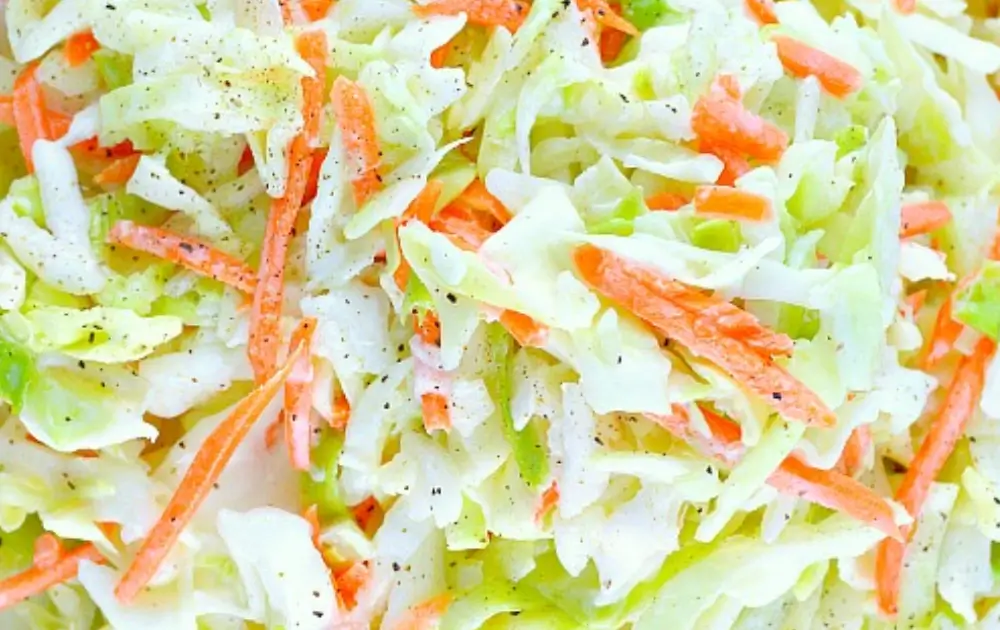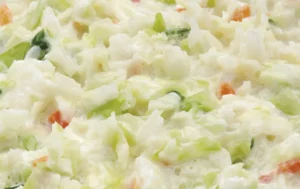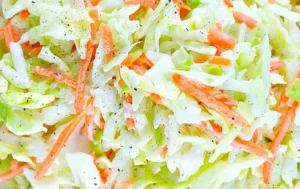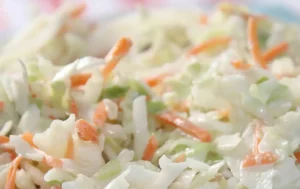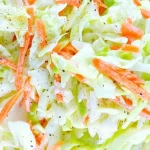Part 1: Introduction to KFC Coleslaw
1. History and Popularity of KFC Coleslaw
KFC Coleslaw, a staple in the fast-food industry, boasts a rich history dating back to the early days of Kentucky Fried Chicken. Colonel Sanders, the founder, recognized the need for a refreshing side to complement his spicy fried chicken, leading to the creation of this iconic coleslaw. Made from a unique blend of fresh cabbage, carrots, and a creamy dressing, it quickly gained fame for its distinct taste and texture. Over the years, this coleslaw has become synonymous with KFC meals worldwide, loved for its consistent quality and the way it balances out the flavors of other dishes. Its popularity also stems from its secret recipe, which, like the original chicken recipe, has been closely guarded, adding to its allure and making it a topic of culinary intrigue among food enthusiasts.
2. Ingredients and Preparation of KFC Coleslaw
The signature taste of KFC Coleslaw is attributed to its carefully selected ingredients and meticulous preparation process. Fresh cabbage and carrots are finely shredded to achieve the perfect texture, ensuring each bite is crisp and flavorful. The creamy dressing, made with a blend of mayonnaise, vinegar, sugar, and a hint of mustard, adds a tangy sweetness that complements the vegetables perfectly. Additionally, a touch of seasoning enhances the overall flavor profile, making it a delightful addition to any meal. The attention to detail in sourcing high-quality ingredients and the precise balance of flavors are what distinguish KFC Coleslaw and contribute to its widespread popularity among consumers.
3. Serving and Pairing Options for KFC Coleslaw
KFC Coleslaw offers versatile serving and pairing options, making it a versatile accompaniment to various meals. Whether enjoyed as a side dish alongside KFC’s famous fried chicken or as a refreshing topping for sandwiches and wraps, its crisp texture and tangy flavor elevate any dining experience. Additionally, it serves as a refreshing contrast to the richness of other dishes, such as barbecue ribs or grilled meats. Its versatility extends to picnics, potlucks, and family gatherings, where it is often a crowd-pleaser. Moreover, KFC Coleslaw can be customized with additional ingredients such as diced apples, raisins, or nuts, adding layers of flavor and texture. This flexibility in serving and pairing options contributes to its enduring popularity and ensures that it remains a beloved choice among consumers worldwide.
4. Why It’s a Favorite Side Dish
KFC Coleslaw holds its status as a favorite side dish for several compelling reasons. Firstly, its creamy and tangy flavor profile offers a delightful contrast to the savory and often spicy main courses, thus creating a balanced meal experience. Secondly, the crispness of the fresh vegetables used in the coleslaw adds a satisfying crunch, enhancing the overall texture of the meal. Moreover, its cool and refreshing nature provides a palate cleanser, making it an excellent accompaniment to heavier, fried foods. Additionally, the versatility of KFC Coleslaw plays a significant role in its popularity; it pairs well with a wide range of dishes, from fried chicken to sandwiches and burgers. Furthermore, its widespread availability in KFC outlets around the globe ensures a familiar and comforting taste that diners can rely on, thus cementing its status as a beloved side dish in the fast-food arena.
Furthermore, the convenience factor contributes to KFC Coleslaw’s popularity as a favorite side dish. It is readily available as part of KFC’s menu offerings, allowing customers to easily add it to their meal orders without any hassle. This accessibility makes it a convenient choice for those looking to enjoy a quick and satisfying meal without sacrificing flavor or quality. Whether dining in at a KFC restaurant or opting for takeout or delivery, customers can easily include KFC Coleslaw as a refreshing accompaniment to their meal.
In addition to its convenience, KFC Coleslaw also appeals to a wide range of taste preferences. While some diners appreciate its classic creamy dressing and crisp vegetable blend, others enjoy experimenting with different flavor combinations. KFC Coleslaw’s versatility allows for customization with additional ingredients such as diced apples, raisins, or nuts, catering to individual preferences and dietary restrictions. This adaptability ensures that KFC Coleslaw remains a favorite side dish among diverse groups of consumers, appealing to varying tastes and preferences.
Moreover, KFC Coleslaw’s reputation for quality and consistency contributes to its status as a favorite side dish. Whether enjoyed at a KFC outlet in one’s hometown or halfway across the globe, customers can expect the same level of freshness and flavor in every serving of KFC Coleslaw. This commitment to quality control and adherence to a tried-and-tested recipe ensures that customers are never disappointed when indulging in this beloved side dish. As a result, KFC Coleslaw continues to garner praise and loyalty from diners worldwide, solidifying its position as a favorite choice among fast-food side dishes.
Furthermore, thorough research is key when dissecting a copycat recipe. Analyzing multiple sources, such as cookbooks, online forums, and cooking blogs, can provide valuable insights into the nuances of the original dish. Paying attention to common ingredients and cooking methods across various recipes can help identify essential elements that contribute to the dish’s authenticity. Additionally, don’t hesitate to experiment with different ingredient ratios or cooking techniques to achieve the desired flavor and texture.
-
Preparation
Once you’ve gathered all the necessary ingredients, it’s time to focus on preparation. Follow the instructions closely, paying attention to specific steps and techniques mentioned in the original recipe. This attention to detail is crucial for replicating the dish accurately. Take note of any special equipment or tools required and ensure you have them on hand before you begin cooking. Additionally, don’t rush through the preparation process; take your time to properly measure ingredients and execute each step with care.
As you progress through the cooking process, taste testing is essential for fine-tuning the flavor profile of your copycat dish. Compare the taste and texture of your creation to the original dish, making adjustments as needed to achieve the desired result. Don’t be afraid to add additional seasonings or ingredients to enhance the flavor or adjust the consistency of the dish. Remember, the goal is to create a copycat recipe that closely resembles the original while still offering your unique twist.
Presentation is also key when serving a copycat dish. Pay attention to details such as plating, garnishes, and serving utensils to recreate the visual appeal of the original dish. Aesthetics play a significant role in enhancing the dining experience and can contribute to the overall enjoyment of your copycat creation. Take cues from the original dish’s presentation and strive to replicate it as closely as possible.
Lastly, don’t forget to document your copycat recipe journey. Keep track of any adjustments or tweaks you make to the recipe, along with your observations and feedback from taste testers. This documentation can serve as a valuable reference for future attempts and allows you to refine your copycat recipe over time. Sharing your recipe and experiences with others through cooking blogs, social media, or online forums can also spark valuable discussions and inspire fellow cooking enthusiasts to embark on their own copycat recipe adventures.
2. Step-by-Step Instructions
Furthermore, maintain the prescribed order in which ingredients are added. This sequence plays a pivotal role in the development of flavors and textures within the dish. Additionally, keep in mind that patience is paramount. Certain steps, such as allowing dough to rise or sauces to simmer, cannot be rushed. It’s essential to allocate sufficient time for these processes to unfold naturally, thereby achieving the desired consistency and depth of flavor in your dish. Remember, exercising patience yields rewarding results in the culinary realm.
-
Flavor profile of your dish
As you progress through each instruction, periodically assess the consistency and flavor profile of your dish. Taste testing allows you to make necessary adjustments along the way, ensuring that the final outcome aligns closely with your expectations. Don’t hesitate to tweak seasoning levels or cooking techniques as needed to achieve the desired result. Moreover, remain adaptable and open to improvisation. Occasionally, unforeseen challenges may arise during the cooking process. Being flexible enables you to navigate these obstacles effectively and make necessary modifications to your approach.
Finally, as you near the completion of the recipe, focus on presentation. Pay attention to details such as plating, garnishes, and serving arrangements to enhance the visual appeal of your dish. A well-presented meal not only pleases the palate but also delights the eyes. Strive to recreate the aesthetic allure of the original dish, while also incorporating your unique creative flair. By following these step-by-step instructions with diligence and creativity, you’ll be well on your way to mastering the art of cooking and creating memorable culinary experiences for yourself and others.

